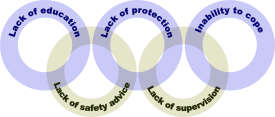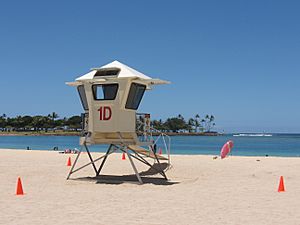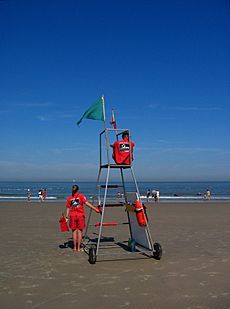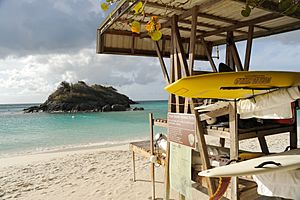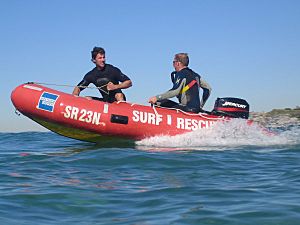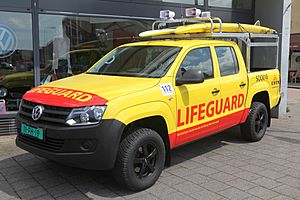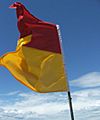Lifeguard facts for kids
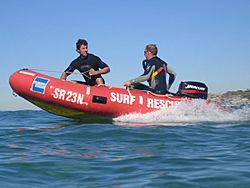
A lifeguard is a person on the beach or at a public pool who educates patrons in the correct way of using the water facility and prevents accidents from happening. They are trained in rescue situations. Lifeguards will usually be found at most public pools and lakes.
Contents
Lifeguarding role
Responsibilities
A lifeguard is responsible for the safety of people in an area of water, and usually a defined area immediately surrounding or adjacent to it, such as a beach next to an ocean or lake. The priority is to ensure no harm comes to users of the area for which they are responsible. Lifeguards often take on this responsibility upon employment, although they can also be volunteers.
The conditions resulting in drowning are summarized by the 'drowning chain' in which each link can lead directly to an incident, or contribute to a succession of links. It consists of lack of education about water safety or local conditions, a lack of safety advice (for example, about rip currents at a beach) a lack of protection (like no flotation device for a weak swimmer), lack of safety supervision, or an inability to cope with conditions (strong surf with a weak swimmer).
The drowning chain provides a clear basis for preventing drowning which includes:
- education and information
- provision of warnings
- denial of access
- supervision
- training in survival skills
The lifeguard is able to provide all these elements to help prevent drownings (or other incidents) in their area of responsibility, and for this reason this should be the primary focus of a lifeguard's activities, as it is better to stop an incident occurring than trying to react once it has occurred. This means that the effectiveness of a lifeguard unit can be measured not by the number or rapidity of rescues, or the skill with which they are executed, but by the absence or reduction of drownings, accidents, and other medical emergencies. Prevention is an effective skill that is vitally important to a lifeguard because it can aid in maintaining the safety of the aquatic patrons.
Lifeguard
Duties
A lifeguard's key duties on a beach (usually as part of a team, but in some places, lifeguards may occasionally be required to work on their own) are to:
- Enforce rules in order to anticipate problems/injuries
- Maintain concentrated observation of the duty area and its users in order to anticipate problems (this will enable the lifeguard to intervene with one of the drowning prevention measures) and to identify an emergency quickly.
- Supervise the use of other equipment when allocated to that duty (such as water slides or any other activities taking place)
- Carry out rescues and initiate other emergency action as necessary
- Give immediate first aid in the event of injury to a bather or other incident
- Communicate with bathers and other users to help fulfill the above tasks
- Help clean areas around pool or beach to ensure the safety and experience for patrons
Lifeguards may have other secondary duties such as cleaning, filing paperwork, checking a swimming pool's chlorine and pH levels, or acting as a general information point. It is important that lifeguards never allow their secondary responsibilities to interfere with their primary responsibilities.
Lifeguards may also be required to attend occasional in-service meetings to strengthen their lifeguarding skills.
Training
Lifeguards are trained in a variety of different lifesaving skills. There are different variations on these skills depending on the various organizations who train lifeguards. The skills also vary depending on the facility in which they will be put to use, such as a shallow water pool, a deep water pool, a water-park facility, or a beach.
Some of the various out-of-water skills taught are:
- Cardiopulmonary Resuscitation (CPR) A series of chest compressions and ventilations that try to circulate blood containing oxygen throughout the body to vital organs in an attempt to resuscitate a victim. New York State requires all lifeguards to renew their CPR certification every year. A lifeguard starting CPR for an adult or child should have two hands on the chest, with the ring finger of the bottom hand lined up with the nipple. The chest compressions should consist of thirty compressions to 2 rescue breaths at a depth of 2 inches for a child and 2-3 inches for an adult. . The rate at which the compressions should be is 100-120 compressions per minute for both child and adult. For an infant, the hand placement should be two fingers at the center of the chest, again just below the nipple line. The depth of compressions should be about one and a half inches with compressions being 30:2. The rate of compressions should be 100-120 compressions per minute.
- Use an AED (Automated External Defibrillators) - Provides an electrical shock that attempts to restore normal heart rhythm in a victim For AED, the information needed is what is in the AED container, where the pads should be placed and how to use the AED. When using an AED, make sure that the device is on. The device should include, a pair of scissors, a razor, and 3 different size AED Pads. The AED pads should be placed on an on the upper right side of the chest, and on the lower left side below the armpit. The pediatric pads should only be used on a child and infant. The placement of the pads for a child is the same as an adult. On an infant place one of the pads on the center of the chest in between the nipples, the other pad should be placed on the back between the shoulder blades.
- First Aid- the lifeguard in training should know how to protect themselves from blood borne pathogens. Lifeguards should protect themselves at all times when performing first aid. When performing first aid the lifeguard should wear latex gloves to protect your hands from coming into contact with the victim’s blood. When performing CPR, the lifeguard should use a pocket mask during mouth-to-mouth resuscitation.
- Emergency Oxygen Administration- Provides emergency oxygen therapy for victims with breathing and cardiac emergencies.
- In-Line Stabilization - A technique used for suspected spinal injuries both in and out of the water that uses the arms to stabilize the head and prevent further movement that could worsen the head, neck, or spinal injury.
- Active and Unconscious Choking - Active choking measures make use of back blows and abdominal thrusts to try and force out the object blocking the victim's airway; Unconscious choking measures are similar to CPR with a few small change. For choking, the information needed is how to help an unconscious and conscious infant, child, and adult victim. For a conscious child or adult start with five back blows and five abdominal thrusts. If at any time the child or adult goes unconscious lower the victim to flat surface and start CPR. According to the American Red Cross Association, a lifeguard should, “Perform a finger sweep to remove a foreign object only if the object is seen.” For a conscious infant, place the infant face down along the forearm against the thigh. Give five back blows in between the shoulder blades with the heel of the hands. Switch the infant over to the other arm face up and give five chest thrusts with two fingers.
- Various First Aid Skills - Used to treat various injuries and sudden illnesses that can occur.
Some of the various in-water skills taught are:
- Active-Victim Rescue - A simple rescue that moves an actively drowning victim to a safer place.
- Passive-Victim Rescue - Saving and removing a victim who is passive (or not moving) in the water; There are variations for both shallow and deep water
- Spinal Rescue - A rescue that assumes a victim has a head, neck, or spinal injury and uses more appropriate measures to ensure that no extra movement creates further harm to the victim; There are variations for both shallow and deep water.
Water Entries
There are four main types of water entries slide- in entry, compact jump, stride jump, and run- and- swim entry.
- Slide-in Entry is the slowest of the four entries. This technique is used when a victim has a suspected head, neck, or spinal injury.
- Stride jump should only be used in water depth of five feet or more and the lifeguard should be no higher than three feet above ground.
- Compact jump can be used from the side of the pool or from the lifeguard chair. The pool depth should be at least five feet if jumping from an elevated position.
- Run-and-Swim entry is used in shallow waters that go from zero-depth to at least three feet.
These entries are used in different scenarios depending on if the victim is passive, or conscious, whether they are in deep or shallow water, and if they have a potential head, neck or spinal injury.
Locations
Lifeguards can be found patrolling many different types of water, and each type has its own unique features, duties and challenges. Locations where lifeguards can be found include:
- Ocean beach - Lifeguards are commonly associated with beaches on the seashore, and this is often considered the most challenging environment to lifeguard due to the influence of external factors such as weather, currents, tides and waves. Life Guards have to be in peak physical condition in order to accommodate these conditions properly.
- Inland body of water (Waterfront) - Lifeguards can also look after open water areas such as rivers, or even lakes or ponds where swimmers may congregate.
- Swimming pool - Most large pools, either indoor or outdoor, are required by law to be patrolled by lifeguards. Nonetheless, smaller pools often do not have qualified personnel.
- Water park - Whilst water parks are a type of swimming pool, they can be considered a unique type of facility as they may involve additional features such as water slides or wave generators, or shallow pool play areas
- Ocean lagoon or tidal pool - These enclosed areas use seawater, but like a pool have a limited and contained area, but have the potential for additional hazards above and beyond an artificial pool
- Waterfront - Lifeguards can look after in a non-surf, open-water areas such as lakes, rivers, streams, and lagoons that are found at public parks, resorts, summer camps and campgrounds.
- Open ocean - In some cases, people may swim in the open ocean from a boat (such as a cruise ship) and lifeguards may be employed for safety in this instance.
Positioning
Lifeguards have a primary duty to supervise the area which they are responsible for, and to achieve this the lifeguard needs to obtain an optimum position for observing the public. This is often best achieved from an elevated position, which can be a chair, platform or even the roof of a vehicle. This allows them maximum visibility over their supervised area and may facilitate communication between them and their team.
Some lifeguard teams use portable platforms or chairs which can be moved to the most appropriate position. This can help take account of changes such as a specific activity taking place, prevailing wind direction or simply enable lifeguards to move closer to the water if the tide goes out on a beach.
The chair or tower can also act as storage for the lifeguard, holding their important rescue or communication equipment close to hand. It can also act as a recognizable point for members of the public to find lifeguard assistance. For this reason, it is often marked with a flag or flags to enable location by the public, and these flags may also give information to the bathers about the conditions for swimming.
Other options, depending on the location, can include patrolling the edge of the water on foot, which allows closer interaction with the public, and the opportunity to provide face to face reassurance and advice, or even supervising from within or on the water, which is most applicable in open water (such as the sea or even a large water park) where lifeguards can use boats or other personal watercraft to be within the water, which extends their range and may allow quicker response to emergencies.
10:20 system
The 10:20 system is a technique taught to lifeguards on many courses including the UK National Pool Lifeguard Qualification and the Ellis & Associates International Lifeguard Training Program (ILTP), which created the concept. It requires scanning from one side of the pool to the other, or the designated area, in 10 seconds, with the lifeguard no further than 20 seconds away from any swimmer who may get into difficulty in the lifeguard's area.
Equipment
Equipment used by lifeguards will vary depending on the location and specific conditions encountered, however certain equipment is relatively universal such as a whistle for attracting the attention of the public or other members of the team, a first aid kit and rescue aids. Other equipment includes, but is not limited to, rescue cans, rescue tubes, rescue boards, spinal boards, AED's, trauma bags, and oxygen.
Rescue aids
There is a hierarchy of rescue techniques, in order, which minimizes danger to the lifeguard and maximizes the effectiveness of a rescue, and this dictates the types of rescue aids that a lifeguard should have available. Lifeguards are supposed to have some equipment to aid rescues. After determining a swimmer is in trouble they try to help in ways that will not result in a threat to the life of the lifeguard or others. This is done by helping at a distance by using a pole; a lifebuoy may be thrown, wading to the victim, using available watercraft, swim with an aid, such as a rescue buoy. As a last resort, direct swimming to the apparent victim.
In addition to these basic lifeguarding techniques, some units are trained in additional water rescue techniques such as scuba diving and swift water training, or in rescue techniques unrelated to water rescue such as abseiling for cliff rescue and bike patrol training, and they will carry appropriate equipment for these.
First aid
Lifeguards are proficient in first aid, and have a well stocked first aid kit available. They may have advanced first aid items such as supplemental oxygen, a suction device, a resuscitator, a defibrillator or AED or a spinal immobilization board. Lifeguards are trained to contact EMS personnel immediately. If a drowning victim has been rescued the victim might need EMS attention or extensive medical treatment.
Certain California Lifeguards are trained in a more extensive advanced first aid that is known as Title 22 First Aid For Public Safety Personnel.
Some lifeguards are crossed trained as Emergency Medical Technicians as a part of their emergency services system.
In certain jurisdictions, lifeguards may use airway adjuncts such as nasopharyngeal airways and oropharyngeal airways.
Rescue boats
Lifeguards will sometimes inflate motor boats in order to save victims that are either far away or when there is large surf, i.e. big waves.
Communications
Effective communications are vital for lifeguards and they may choose to use whistles, two-way radios, megaphones or even signal flares.
A more traditional method of communication with the public is through the use of colored flags, which can be raised over permanent or temporary flag poles to inform members of the public of different information.
More often than not a whistle is used in the pool leisure facility (public and private), the following signals are used by some lifeguards with a whistle (Note: it is always important to remember that each facility may have their own standards and procedures for their whistle protocol).
- 1 short blast - used to gain the attention of a swimmer.
- 2 short blasts - used to gain the attention of fellow lifeguards (including managers/head lifeguards)
- 3 short blasts - used to signal that a lifeguard is taking action in their area.
- 1 long blast - (swimming pools) used to clear the pool
- 1 long blast - used to signal to a fellow lifeguard that you are jumping in for an active save.
- 2 long blows - used to signal to swimmers that they must clear the pool, this could be because the pool is closed or an emergency is taking place significant enough for the lifeguards to clear the pool.
Transportation
For duty areas over a wide area, such as beaches and lakes, lifeguards may require transport over distance and they may use land transport including pick-up trucks, quad bikes, gators, or other off-road vehicle.
They may also use larger water crafts such as a large rigid or inflatable boats, personal water crafts, or even hovercrafts.
Images for kids
-
A lifeguard (United States) on patrol during Hurricane Earl.
-
Two lifeguards of the German DLRG patrolling a public bathing area of a lake on stand-up paddleboards in Munich
-
Lifeguard tower with yellow and purple flag in Miami Beach
-
Lifeguard tower, Asprovalta (Greece)
-
Sign in Bray, Ireland explaining lifeguard flags.
-
Lifeguard in Barcelona
-
Lifeguard pick-up truck of the RNLI
-
Lifeguard tower and truck in Ocean Beach, San Diego, California
See also
 In Spanish: Socorrista acuático para niños
In Spanish: Socorrista acuático para niños



